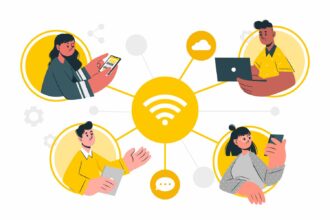Remote access for desktops can be a huge convenience, but only if it is set up securely. Many people avoid setting up remote access because they think it is complicated and confusing. However, this process can be completed in 7 easy steps! In this blog post, we will walk you through each step, so you can enable secure remote access to your desktop quickly and easily.
Use strong passwords
This is one of the most important steps in ensuring your remote access is secure. Your password should be at least eight characters long and include a mix of uppercase and lowercase letters, numbers, and special characters. You should also avoid using easily guessed words like “password” or your name. When enabling your remote desktop access, be sure to set a strong password that you will remember. It often happens that people set up a password that is too complicated and then forget it, which can be a huge headache. This is why it is important to find a balance between complexity and memorability. You can also use a password manager to generate and store your passwords, so you don’t have to remember them all yourself. Keep in mind, though, that if your password manager is not set up securely, it could defeat the purpose of using a strong password in the first place.
Use Two-factor authentication
Two-factor authentication (also known as two-step verification) is an important security measure that you should take when setting up remote access to your desktop. This means that in addition to your password, you will also need another form of identification, such as a code from a text message or an app on your phone, to log in. This provides an extra layer of protection in case your password is compromised. Many remote desktop applications offer two-factor authentication, so be sure to enable it if possible. If your remote desktop application does not offer two-factor authentication, there are other ways to set it up. For example, you can use a third-party service like Google Authenticator or Authy. They provide a code that you need to log in, and they can be set up to work with many different applications.
Update your software
It is important to keep your operating system and software up to date to maintain a high level of security. This is especially true for remote desktops, as outdated software can provide a way for hackers to gain access to your computer. When new updates are available, be sure to install them as soon as possible. You can usually set your computer to install updates automatically, which is a good idea if you want to make sure you’re always using the most up-to-date software. However, even with automatic updates, it’s a good idea to check for updates regularly and install them manually if necessary.
Restrict access using firewalls
A firewall is a piece of software that blocks incoming connections that are not authorized. This is an important security measure to take when setting up remote access to your desktop, as it will help to prevent unauthorized users from gaining access to your computer. There are many different firewalls available, and which one you use will depend on your operating system and needs. If you’re not sure which firewall to use, you can ask your IT department or search for a firewall that is compatible with your operating system. Once you have chosen a firewall, be sure to configure it properly. This usually involves creating rules that allow certain types of traffic and block others.
Enable Network Level Authentication
Network Level Authentication is a security feature that is available in Windows Vista and later. It requires that users authenticate with a username and password before they can connect to the remote desktop. This helps to prevent unauthorized access, as it requires that users have a valid account on the computer before they can connect. To enable Network Level Authentication, open the Remote Desktop Connection application and click on the Advanced tab. Then, select the “Enable Network Level Authentication” option. Keep in mind that this option is only available if you are using the Windows Vista or later operating system. If you are using an earlier version of Windows, you will need to upgrade to use this feature.
Limit users who can log in using Remote Desktop
Another security measure that you can take is to limit the number of users who can log in using Remote Desktop. This can be done by opening the System Properties dialog box and clicking on the “Remote” tab. Then, select the “Allow only specific users to connect” option and click on the “Add…” button. You will then be able to add the users to who you want to be able to connect. This is a good way to limit access to your computer, as it ensures that only authorized users can gain access. Consider adding only those users who need access, such as your IT department or a remote support team.
Set an account lockout policy
An account lockout policy is a security measure that helps to prevent brute force attacks. A brute force attack is when a hacker tries to guess a user’s password by trying different combinations of characters. If they are successful, they can gain access to the account. To help prevent this type of attack, you can set an account lockout policy. This will lock the account after a certain number of failed login attempts. To set an account lockout policy, open the Local Security Policy editor and navigate to the “Account Policies” -> “Account Lockout Policy” section. From here, you can configure the desired settings. It is generally recommended to lock the account after a few failed login attempts, such as three or five.
There are several steps that you can take to enable secure remote access for your desktop. By following the steps outlined above, you can help to ensure that only authorized users can gain access to your computer. Additionally, these steps will help to prevent brute force attacks and other security threats. Implementing these measures will help to keep your computer safe and secure.









